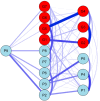Network analysis of suicide ideation and depression-anxiety symptoms among Chinese adolescents
- PMID: 38562407
- PMCID: PMC10982688
- DOI: 10.1136/gpsych-2023-101225
Network analysis of suicide ideation and depression-anxiety symptoms among Chinese adolescents
Abstract
Background: The co-occurrence of depression and anxiety among adolescents is typically associated with suicide ideation.
Aims: The study aimed to investigate the symptom-level relationship between suicide ideation and the comorbidity of depression and anxiety.
Methods: 1501 adolescents aged 12-19 years were assessed using the Patient Health Questionnaire (PHQ-9) and the Generalized Anxiety Disorder Scale, and 716 adolescents who scored ≥5 on both scales were selected as participants. Network analysis was used to identify the network structure of depressive symptoms and anxiety symptoms. Participants were categorised into either the suicide ideation or non-suicide ideation groups based on their scoring on the suicide-related item in PHQ-9. A comparison was made between the depression-anxiety symptom networks of the two groups.
Results: 'Restlessness', 'sad mood' and 'trouble relaxing' were the most prominent central symptoms in the depression-anxiety symptom network, and 'restlessness', 'nervousness' and 'reduced movement' were the bridge symptoms in this network. 'Sad mood' was found to be directly related to 'suicide ideation' with the highest variance. The network structure was significantly different in properties between the suicide ideation group and the non-suicide ideation group, with 'restlessness' and 'sad mood' exhibiting significantly higher influence in the network of the suicide ideation group than that in the non-suicide ideation group.
Conclusion: Restlessness and sad mood could be targeted for the intervention of depression-anxiety symptoms among adolescents with suicide ideation.
Keywords: Adolescent Behavior; Anxiety; Depression; Suicidal Ideation.
© Author(s) (or their employer(s)) 2024. Re-use permitted under CC BY-NC. No commercial re-use. See rights and permissions. Published by BMJ.
Conflict of interest statement
Competing interests: None declared.
Figures




Similar articles
-
Centrality depression-anxiety symptoms linked to suicidal ideation among depressed college students--A network approach.Psych J. 2023 Oct;12(5):735-745. doi: 10.1002/pchj.668. Epub 2023 Jul 11. Psych J. 2023. PMID: 37433668
-
Inter-relationships of depressive and anxiety symptoms with suicidality among adolescents: A network perspective.J Affect Disord. 2023 Mar 1;324:480-488. doi: 10.1016/j.jad.2022.12.093. Epub 2022 Dec 28. J Affect Disord. 2023. PMID: 36584712
-
Prevalence and network structure of depression, anxiety and adverse doctor-patient relationship risks among patients with physical diseases: A cross-sectional study.J Affect Disord. 2025 May 1;376:122-130. doi: 10.1016/j.jad.2025.01.144. Epub 2025 Jan 28. J Affect Disord. 2025. PMID: 39884365
-
A network model of depressive and anxiety symptoms: a statistical evaluation.Mol Psychiatry. 2024 Mar;29(3):767-781. doi: 10.1038/s41380-023-02369-5. Epub 2024 Jan 18. Mol Psychiatry. 2024. PMID: 38238548 Free PMC article.
-
Prevalence of depression, anxiety and suicide among men who have sex with men in China: a systematic review and meta-analysis.Epidemiol Psychiatr Sci. 2020 Jun 15;29:e136. doi: 10.1017/S2045796020000487. Epidemiol Psychiatr Sci. 2020. PMID: 32536353 Free PMC article.
Cited by
-
Sex and age differences in depression and anxiety networks among adolescents with idiopathic scoliosis: A network analysis.World J Psychiatry. 2025 Mar 19;15(3):102790. doi: 10.5498/wjp.v15.i3.102790. eCollection 2025 Mar 19. World J Psychiatry. 2025. PMID: 40110004 Free PMC article.
-
The mediating role of depressive symptoms in the relationship between health literacy and suicide-related behaviors in middle school students.Sci Rep. 2025 May 23;15(1):17914. doi: 10.1038/s41598-025-02868-1. Sci Rep. 2025. PMID: 40410258 Free PMC article.
-
A Four-Week High-Fat Diet Induces Anxiolytic-like Behaviors through Mature BDNF in the mPFC of Mice.Brain Sci. 2024 Apr 17;14(4):389. doi: 10.3390/brainsci14040389. Brain Sci. 2024. PMID: 38672038 Free PMC article.
-
Construction and validation of a predictive model for suicidal ideation in non-psychiatric elderly inpatients.BMC Geriatr. 2025 May 9;25(1):322. doi: 10.1186/s12877-025-05980-z. BMC Geriatr. 2025. PMID: 40346469 Free PMC article.
-
Factors Associated with Suicidal Behavior in Adolescents: An Umbrella Review Using the Socio-Ecological Model.Community Ment Health J. 2025 May;61(4):612-628. doi: 10.1007/s10597-024-01368-2. Epub 2024 Nov 2. Community Ment Health J. 2025. PMID: 39487937 Free PMC article.
References
-
- Mahumud RA, Dawson AJ, Chen W, et al. . The risk and protective factors for suicidal burden among 251 763 school-based adolescents in 77 low- and middle-income to high-income countries: assessing global, regional and national variations. Psychol Med 2022;52:379–97. 10.1017/S0033291721002774 - DOI - PubMed
LinkOut - more resources
Full Text Sources
